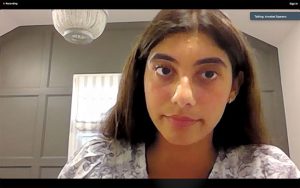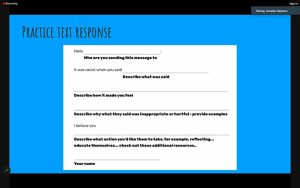
Annabel Sparano, the 15-year-old winner of the 2023 Dr. Martin Luther King Jr. YMCA Essay Contest, is the youngest person to host a Red Bank Public Library Let’s Talk About Race program. Screenshot / Red Bank Library
By Sunayana Prabhu
RED BANK – In a timely conversation before schools reopen, Annabel Sparano, a 10th-grade student at Ranney School in Tinton Falls, presented methods for combating verbal abuses during the latest Let’s Talk About Race program hosted virtually by the Red Bank Public Library.
During the July 26 program, titled Speak Up: Verbal Responses To Racism, the 15-year-old winner of the YMCA’s 2023 Dr. Martin Luther King Jr. Essay Contest, shed light on how everyone can use their voice effectively to create change. She also offered suggestions for preparing responses to intimidating situations before they arise, which can be empowering and build confidence in those of all ages.
Annabel shared her personal story and then explained her ideas for implementing change within the community, including creating discussion forums in area schools “so that students my age can really just open up about their opinions and respectfully listen and share their experiences,” she said.
As a child of an Italian father and mother of Indian descent, Annabel said she is often (rudely) asked, “What are you?” Her response? “I’m American. But what is my heritage? I’m half Indian, half Italian.”
She also shared an anecdote that inspired her to engage with the community. When she was 13 a group of boys made racist comments about her during a FaceTime call. “I didn’t really know how to respond,” she said and has carried the “guilt and embarrassment and regret all bundled into one” because she didn’t “stick up” for herself.
The problem, Annabel said, was not that she didn’t want to respond but that she didn’t know how to.
During the talk she presented a step-by-step process for creating “canned responses” that can be applied to many uncomfortable situations, not just racist comments.
Annabel shared questions students can ask themselves before responding, including determining the power dynamic and context of the situation. If at any time the situation feels overwhelming, Annabel said avoidance is a reasonable response. “It’s arguably even more effective to share your response after you’ve had a little bit of time to plan what you want to say, instead of just blurting out some bad comeback.”
Determining if it is safe to respond is paramount because there could be “dangerous consequences.” Lastly, consider where and how you want to respond: publicly, on social media, in a text, or in a private conversation.
After choosing when and where to respond, Annabel noted there are also different ways to respond: question, inform, rephrase, withdraw, report or directly challenge.

A text response template is one of the tactics Annabel Sparano shared during her presentation to help students or anyone in a contentious situation set the right tone. Screenshot / Red Bank Library
Responding to a racist comment with a question such as, “Where did you hear that from?” is a way to undermine an argument “without being aggressive,” she said.
Informing people is also a great way to respond because “lack of awareness” or understanding is often at the root of racism.
By rephrasing “you almost do the correcting for them,” she said, but also admitted sometimes it is just not “worth the battle.” Sometimes “it’s just best to withdraw and wait” for a better time.
Directly challenging someone doesn’t mean “personally attacking” them, Annabel said, but rather is about “expressing how you feel in an assertive and polite manner.” That can mean telling the person, “I wouldn’t want a friend saying those things to me” or simply replying with two words: “That’s racist.”
Reporting the incident or someone’s behavior to a teacher, principal or other authority figure is best reserved for times when the situation feels threatening, abusive or when other responses don’t work. Providing a nonaggressive warning can also help combat racist remarks: Saying, “ ‘If something like this happens again, I’ll be going to the teacher, I’ll be going to the principal,’ ” could quash repeated racist comments.
On a “grand scale” Annabel said, people understand it’s not “socially acceptable to be racist” but she drew attention to “microaggressions,” the conscious and unconscious beliefs ingrained in people that may erupt in comments like, “You’re so articulate, you don’t sound Black” or behaviors such as calling the police on someone because of the color of their skin or clutching your purse when walking past someone of a different race.
Calling out racism when you see it is an important step in countering microaggressions, Annabel said. “For example, asking ‘Why are you clutching your purse like that?’ ” could lead someone to reconsider their behavior, she said. Educating the perpetrator is effective in disarming microaggression.
Annabel said she feels racism is “generational.” She notes many kids think and act like their parents. “So, it’s very uncommon to see teenagers who have different opinions from their parents,” she said. But she urges those her age to try to break that cycle, even if it is difficult, even if it is simply saying something as casual as “Hey, that’s not cool.”
Annabel serves her community through various local organizations as a volunteer and is currently studying the relationship between music, neurobiochemistry and human psychology.
This month, the Red Bank Public Library celebrates the ninth anniversary of the Let’s Talk About Race series. The series won a state award for Best Multicultural Program.
The article originally appeared in the August 17 – 23, 2023 print edition of The Two River Times.














